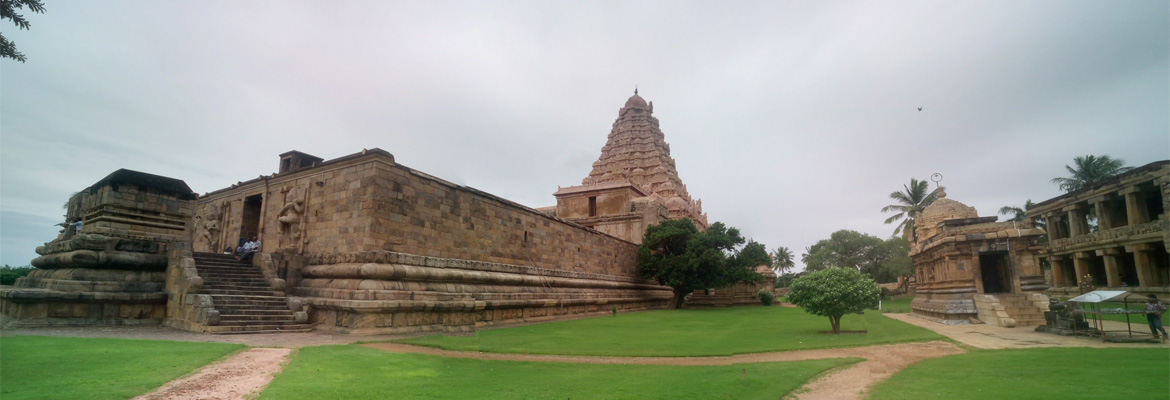History
The Gangaikonda Cholapuram Temple, located in Tamil Nadu, is a magnificent example of Chola architecture and a testament to the power and artistry of the Chola dynasty. Built in the 11th century by Rajendra Chola I, the temple was constructed to commemorate his victorious expedition to the Ganges and to establish his new capital, Gangaikonda Cholapuram. Dedicated to Lord Shiva, the temple features a towering vimana (temple tower) that, though slightly shorter, rivals the grandeur of the Brihadeeswarar Temple in Thanjavur.
The temple is known for its intricate stone carvings, sculptural richness, and the harmonious proportions of its structure. The sanctum houses a massive Shiva Lingam, one of the largest in South India, symbolizing the divine energy and supremacy of Lord Shiva. Despite centuries of historical changes and political shifts, the temple has retained its spiritual significance and architectural brilliance. Surrounded by a serene atmosphere and less crowded than other major temples, Gangaikonda Cholapuram offers visitors a chance to experience the legacy of Chola art, devotion, and imperial ambition in a setting of quiet reverence.
Greatness:
The Gangaikonda Cholapuram Temple, located in Tamil Nadu, is a magnificent example of Chola-era architecture and one of the finest monuments in India’s rich cultural and historical landscape. Built in the 11th century by Rajendra Chola I to commemorate his victorious expedition to the Ganges, the temple stands as a symbol of imperial power, artistic excellence, and religious devotion. Dedicated to Lord Shiva, the temple’s massive vimana (tower) rises majestically, slightly shorter but more intricately detailed than that of its predecessor, the Brihadeeswarar Temple in Thanjavur. The sanctum, adorned with a grand Shiva Lingam, exudes spiritual serenity, while the sculptural artistry throughout the complex reflects the Cholas’ mastery of stone work and symbolism. Recognized as a UNESCO World Heritage Site, Gangaikonda Cholapuram is not only a sacred shrine but also a living legacy of Tamil heritage and one of the greatest architectural achievements of South India.

Specialities:
The Gangaikonda Cholapuram Temple, located in Tamil Nadu, is a magnificent 11th-century Hindu temple built by the Chola emperor Rajendra Chola I to commemorate his victorious campaign to the Ganges River. Dedicated to Lord Shiva, this temple stands as a stunning example of Chola architecture and artistry, rivaling even the famous Brihadeeswarar Temple in Thanjavur.
Its name means “The City of the Ganges Conqueror,” symbolizing Rajendra Chola’s imperial power and devotion.The temple is renowned for its grand vimana (tower above the sanctum), which soars impressively with intricate carvings and sculptures portraying deities, mythical creatures, and scenes from Hindu mythology. Its spacious courtyard, massive pillared halls, and beautifully sculpted pillars showcase the architectural genius and cultural richness of the Chola period. Unlike many temples, Gangaikonda Cholapuram has remarkably preserved its original form, offering a glimpse into the grandeur of medieval South Indian temple construction. The temple remains an active center of worship and a testament to the Chola dynasty’s artistic and religious legacy.
Festivals:
- Karthigai Deepam
- Navaratri
- Arudra Darshan (Thiruvathirai)
- Pradosham
- Maha Shivaratri
Timings:
- Morning: 6:00 AM – 12:00 PM
- Evening: 4:00 PM – 7:00 PM
FAQs
The temple is located in Gangaikonda Cholapuram, a town in Ariyalur district, Tamil Nadu, India. It is about 70 km from the city of Trichy (Tiruchirappalli)
The temple is dedicated to Lord Shiva, worshipped here as Gangaikonda Cholapurathar, meaning “The King who conquered the Ganges.”
Built in the 11th century by Rajendra Chola I, this temple commemorates his victorious northern expedition to the Ganges River. It served as the capital of the Chola dynasty for around 250 years.
The temple grounds are relatively accessible, but there may be uneven terrain. Assistance may be required for elderly or differently-abled visitors.


